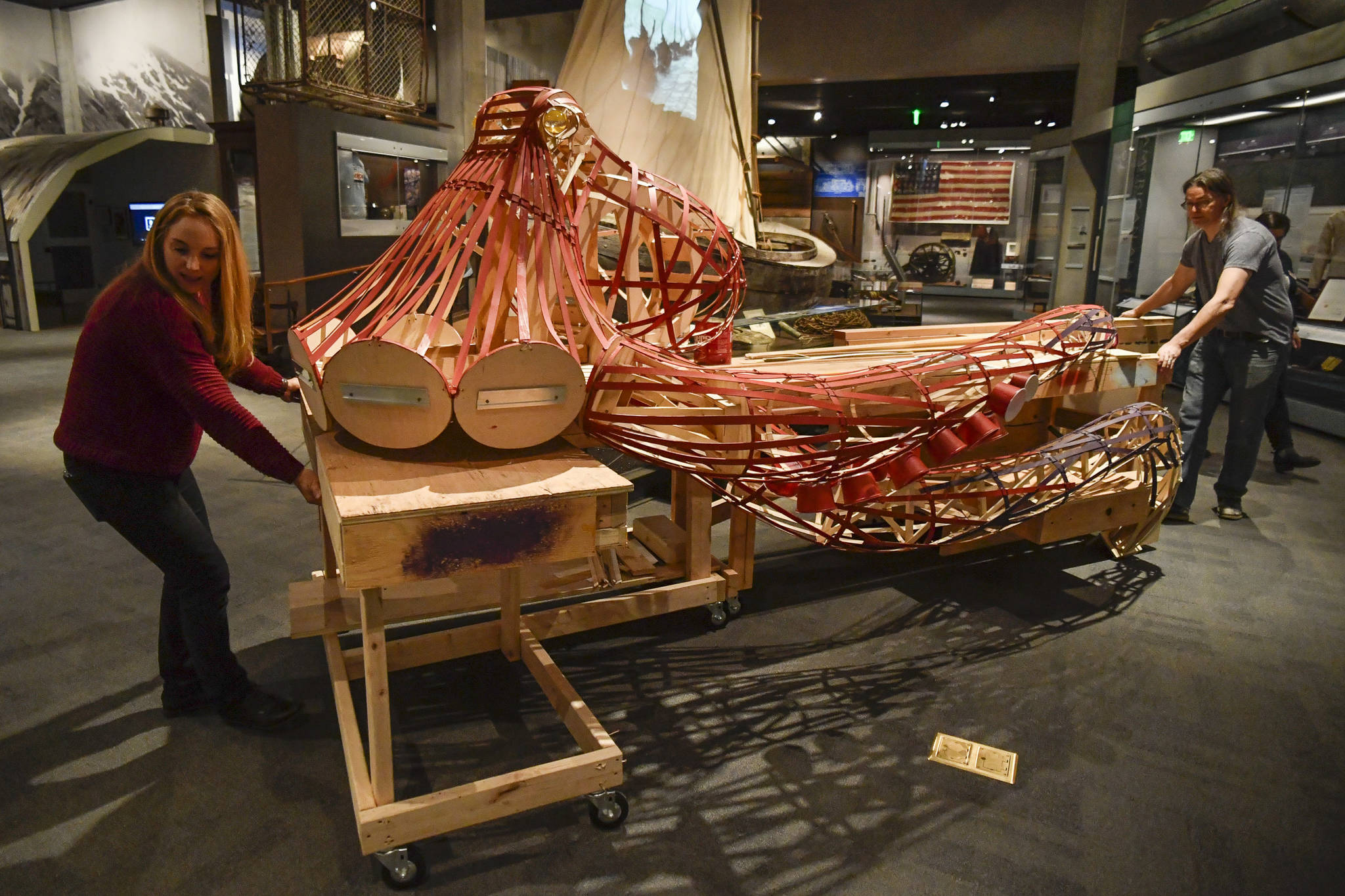Children will soon get their hands on eight arms.
In a few weeks, youths will assist in completing The Alaska State Museum’s new giant Pacific octopus installation built by exhibit specialist Aaron Elmore when kids create artwork that will decorate the creature’s suction cups.
“Their art will be visible and shining out into the Discovery Room,” Elmore said.
[Octopus art piece coming to Alaska State Museum]
The project, which will ultimately bring an octopus made of plywood with 14-foot-long arms to the museum’s youth room that houses a scale model of a ship, has been in the works since about July.
It is intended to liven up the Discovery Room and serve as an attention-grabbing way to teach young museum-goers about the oceans and their inhabitants.
The giant wooden mollusc was on the move Tuesday away from the museum’s workshop to a temporarily open gallery space that will allow the public to assist with completing the octopus.
“It’s going to be lonely in here without it,” Elmore said while surveying the museum’s workshop. “The shop has been completely overwhelmed by the project.”
The artwork that will help cover the skeletal structure will be made during youth activity sessions on Saturday, March 23 and Saturday, March 30.
More information about those sessions, such as what age groups will be allowed to participate and exact times, will come closer to the dates, said curator of exhibitions Jackie Manning.
Then it will be time to put the octopus together, and the plan is to have the entirety of the project done by April 5, which coincides with that month’s First Friday arts event.
“We’re talking about an unveiling,” Manning said.
She said those in attendance at the opening will be encouraged to dress as their favorite sea creature.
Before kids decorate the octopus, adults will get their chance to make a mark on the creature.
During the entire first half of March — Tuesday through Saturday, March 1-March 16 — people are invited to drop-in at the museum to help make cloth circles that will help cover the octopus’ wooden frame.
Elmore said no stitching background is required to help out with the project, and the cloth used will be recycled material.
He’s already made a few bags of cloth circles, and local artist Dianne Anderson and Elmore’s mom have also chipped some circles in.
“Everyone who stitches has this material in their lives sometimes to an embarrassing degree,” Elmore said.
Circular plastic container lids will also be used to cover some of the octopus’ surface area.
Elmore and Manning said that’s because the project’s goal is to teach youths about the animals that live in the ocean near Juneau, such as the giant Pacific octopus, and the impact trash has on them.
However, making the skin entirely out of lids would have required a preposterous amount of secondhand plastic, Elmore said.
Elmore said by using repurposed materials and community support, the cost associated with the project is staying low, but he did not have an exact figure to provide.
When people stop by the museum to help make the octopus’ skin, they will also be able to submit names, Manning said.
Elmore said the plan is to have museum staff choose a name for the octopus based on a public submission.
The octopus was built without the modified arm found on males of the giant Pacific octopus species, so Manning said suggested female names would be appropriate.
“We have to name this octopus,” Manning said.
Weird science
While the unnamed octopus is a whimsical work, real-life facts helped shape it.
Sherry Tamone, professor of marine biology for University of Alaska Southeast, and Riley Woodford with Alaska Department of Fish & Game provided input to keep the project’s depiction of an octopus fairly realistic even if it is fantastically large and will sport a patchwork skin.
[Octopus says goodbye to DIPAC aquarium keeper]
Tanna Peters was also an art consultant for the project.
Plans are in place to include some displays that will include some information about giant Pacific octopuses, which typically grow to be about 6 feet long and live for about five years.
Once the the octopus is pieced together and installed, it will interact with many of the museum’s surfaces. Its appendages will take on the characteristics of the item its touching.
For example, the arm touching glass will feature a transparent tip, and the arm touching the I Spy Wall will feature eclectic clutter.
This mirrors the octopus’ real life ability to change colors and textures, which will also be reflected by the project’s crowd-sourced cloth skin.
“That’s sort of what this represents,” Elmore said. “It’s also an easier thing than collecting plastic.”
[Weavers from all over contribute to Giving Strength Robe]
• Contact arts and culture reporter Ben Hohenstatt at (907)523-2243 or bhohenstatt@juneauempire.com. Follow him on Twitter @BenHohenstatt.

